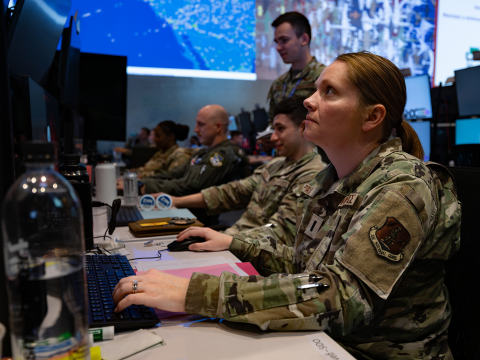Victory Has a New Definition
Information is the Swiss Army Knife of the tactical warfighter. It is a multifaceted tool that can be applied to a wide range of functions, many of which have unintended benefits. It is rapidly migrating from a warfighter’s helper to a more central role in military operations. In this era of network-centric warfare, information is a weapon, and its enabling hardware are becoming weapon systems.
We have gone far beyond the seemingly distant days of command, control, communications and intelligence serving as "the ultimate force multiplier." Now, bytes have become bullets for the information warrior. This paradigm shift alters more than the means and methods of warfare. It also promises to change the very definition of success in the theater of operations.
History is replete with examples of new technologies moving the finish line of warfare. Gunpowder rendered fortress sieges unnecessary and castles obsolete. The tank ended the era of massed human forces holding territorial lines and ushered in mobile warfighting. Airpower extended the battlespace to combatants’ capitals and emphasized the concept of strategic warfare.
Yet, throughout all of these developments, the goal of victory in warfare remained constant: retain or capture territory. The tactics changed, but the definition of victory was the same. The winner would raise its flag over the piece of real estate it needed to symbolize the defeat of an adversary.
However, information operations has changed both the battlefield and the definition of a successful outcome. Warfare is no longer merely a battle for territory. Now, combat may seek a purely political outcome instead of a geographic goal. And, this combat may be waged successfully without firing a shot.
Recent examples of conflict show how this trend has been evolving. The Gulf War in 1991 arguably was the first war where high-technology information systems dominated the battlespace. This gave the West a taste of how these new technologies could control the agenda in combat.
Last year’s Kosovo operation marked a greater shift in the definition of tactical success. Waves of air attacks were built around a crackling stream of information networked among North Atlantic Treaty Organization (NATO) allies throughout Europe and North America. Land- and carrier-based aircraft operating from nearby sites filled the skies with air strikes built around various forms of intelligence. Cruise missiles employed precise navigation and tracking to achieve pinpoint accuracy on their targets. Air tasking orders dispatched U.S. Air Force B-2 Spirit bombers from their bases in the U.S. heartland on round-trip bombing missions over Serbia. Their aircrews literally commuted from their homes to the theater of operations and back.
In the end, Yugoslavia’s leader Slobodan Milosevic capitulated to NATO’s demands in Kosovo. Not a single U.S. airman was lost to enemy fire. Neither was a single ground combatant deployed to seize a kilometer of territory. The operation’s political goals were achieved by forces built around networked information.
The trend is clear. Information is becoming not just a weapon but the weapon of choice. Its systems—networks, intelligence-gathering platforms and command and control centers—are the weapon systems of the new millennium. And, it ultimately will change the definition of success in warfare.
We may be moving from the tenet of mutually assured destruction that characterized the Cold War to one of information-assured negation. As tensions rise during a crisis, allied forces might use their superior information assets to convince an adversary to back down without resorting to combat. The shot across the bow may be replaced by a byte in the database that leads would-be foes to yield to visible supremacy.
If intimidation does not work, then information assets can direct conventional weapons to inflict minimum damage with maximum efficiency. The key is that the information systems would be the assets employing munitions to achieve operational goals set by commanders. Silicon would wield iron as its enabler, instead of the reverse.
The information tools available to the tactical warrior are more diverse than combat network radios. In addition to technologies and services, the commercial sector can provide its own assets that can be used by military forces to bring about desired tactical goals. For example, U.S. experts are factoring in the omnipresence of live video media such as CNN as they plan future operations. While this coverage could reveal allied maneuvers to an enemy, it also could serve to carry a message to the same adversaries. This might range from misleading tactical information to an implied "resistance is futile" directive. It is far easier to incorporate independent information into planning than it is to try to counter it.
Ultimately, the decision to continue a fight or throw in the towel will be made by humans. And, information is the single biggest influence on human behavior, either directly or indirectly.
The metamorphosis of information in military operations is maturing rapidly. No longer will it always be necessary for forces to seize territory to achieve victory. Warfighters are nearing the day when the facts in their power become the fact of their power. Advanced information technologies will make that happen.




Comments